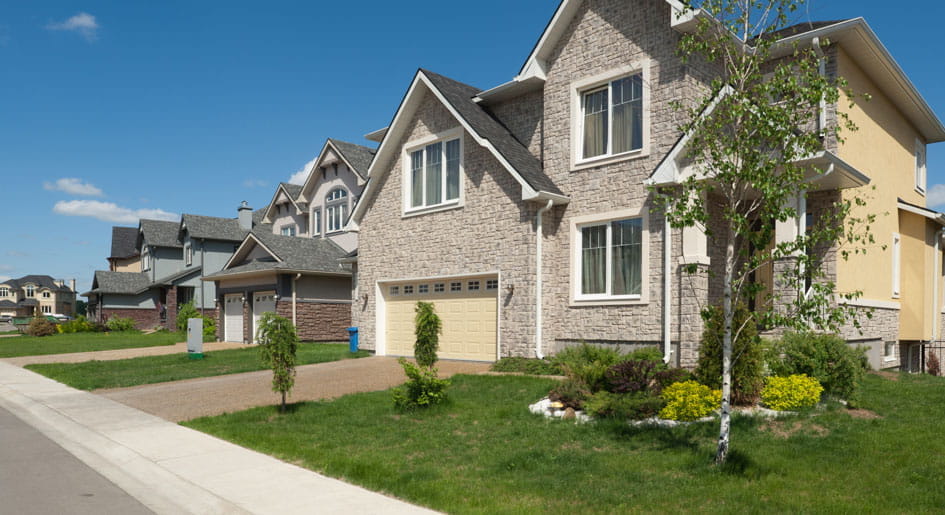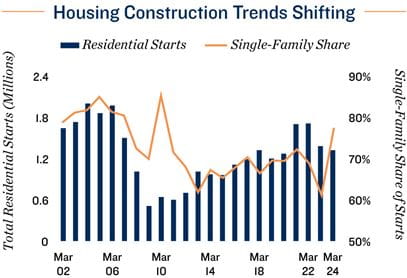Research Brief
Housing
April 2024

Divergent Residential Construction May
Provide Greater Balance Longer Term
Single-family accounts for a growing share of development. Multifamily and single-family construction trends are moving in opposite trajectories, as the apartment sector responds to a supply-induced fundamental softening while the home market remains substantially undersupplied. In March 2024, single-family houses comprised over 77 percent of residential starts, the highest share for that month since 2010. That same dynamic is likely to continue as well, with multifamily permit activity falling 20 percent year-over-year in March while single-family permits increased by nearly that same margin. These divergent trends should be beneficial for both sectors longer term. A shortage of single-family homes on the market has fueled robust appreciation, which, paired with elevated interest rates, has put homeownership out of reach for a rising share of the population. Multifamily development accelerated to help fill the gap; however, that ongoing supply infusion is putting upward pressure on vacancy. A longer-term hike in homebuilding and a deceleration in multifamily construction should help provide greater parity.
 Apartment demand surges, but still outpaced by new supply. Multifamily net absorption reached almost 104,000 units from January through March 2024, the strongest first quarter on record. Nevertheless, historic demand still fell short of new supply, maintaining upward vacancy pressure. This foreshadows the remainder of 2024, with annual net absorption on pace to be at the second-highest level on record, yet vacancy will rise modestly.
Apartment demand surges, but still outpaced by new supply. Multifamily net absorption reached almost 104,000 units from January through March 2024, the strongest first quarter on record. Nevertheless, historic demand still fell short of new supply, maintaining upward vacancy pressure. This foreshadows the remainder of 2024, with annual net absorption on pace to be at the second-highest level on record, yet vacancy will rise modestly.
Appetite for newly-built homes encouraging builders. New home sales rose by 8 percent year-over-year in March to reach a six-month high. Correspondingly, the homebuilder confidence index increased relative to the same month one year prior. The continuation of this trend could help motivate construction and loosen the overall single-family housing market. As residents move up the quality stack into newly-built homes, it should result in more existing houses being listed on the market. This has already begun to materialize, with the number of existing homes for sale climbing 13 percent year-over-year in March.
Developing Trends
Existing home prices fell to a three-month low. After hitting an all-time high during February 2024, the median sale price of an existing single-family home fell 0.9 percent month-over-month to $402,200. This slight price reduction occurred as the number of home listings increased to a 41-month high, while the volume of sales for these dwellings dipped 3 percent year-over-year. Home sellers may be losing modest leverage in the market; however, a major price reduction is not expected, given the still-low number of homes available for purchase. Despite rising to the highest count since October 2020, the number of existing houses for sale in March trailed the past-decade average by almost 25 percent.
Persistently elevated borrowing costs offset lower prices. The rise in existing home listings in March, alongside a decline in sales, was the first time that has happened in 2024. Previously, buyers had strongly responded to an increase in houses available for purchase, which helped push prices to an all-time high in February. A key differentiator may have been the average 30-year mortgage rate, which ticked up to a three-month high in March.
21.2% |
-44.3% |
|
Year-Over-Year Change in Single-Family Starts |
Year-Over-Year Change in Multifamily Starts |
Sources: Marcus & Millichap Research Services; Capital Economics; Freddie Mac; Moody’s Analytics;
Mortgage Bankers Association; National Association of Home Builders; National Association of Realtors;
RealPage, Inc.; U.S. Bureau of Labor Statistics; U.S. Census Bureau; Wells Fargo
TO READ THE FULL ARTICLE
